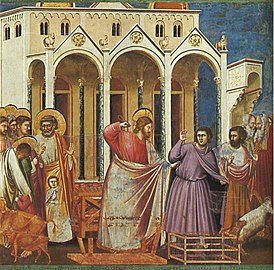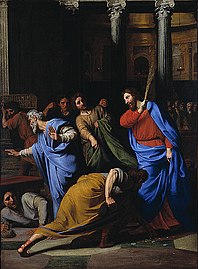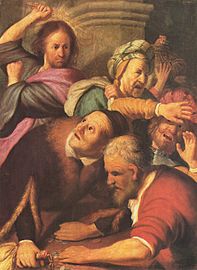Cleansing of the Temple

canonical gospels |
 |
|
Portals: |
The cleansing of the Temple narrative tells of
In this
The narrative occurs near the end of the Synoptic Gospels (at Matthew 21:12–17, Mark 11:15–19, and Luke 19:45–48) and near the start of the Gospel of John (at John 2:13–16). Some scholars believe that these refer to two separate incidents, given that the Gospel of John also includes more than one Passover.[1]
Description

Jesus is stated to have visited the
And when he had made a scourge of small cords, he drove them all out of the temple, and the sheep, and the oxen; and poured out the changers' money, and overthrew the tables; And said unto them that sold doves, Take these things hence; make not my Father's house a house of merchandise.
And Jesus went into the temple of God, and cast out all them that sold and bought in the temple, and overthrew the tables of the money changers, and the seats of them that sold doves, And said unto them, It is written, My house shall be called the house of prayer; but ye have made it a den of thieves.
In Mark 12:40 and Luke 20:47 Jesus accused the Temple authorities of thieving and, in this instance, names poor widows as their victims, going on to provide evidence of this in Mark 12:42 and Luke 21:2. Dove sellers were selling doves that were sacrificed by the poor, who could not afford grander sacrifices, and specifically by women. According to Mark 11:16, Jesus then put an embargo on people carrying any merchandise through the Temple, a sanction which would have disrupted all commerce.
Matthew 21:14–16 says the Temple leaders questioned Jesus, asking whether he was aware that the children were shouting "Hosanna to the Son of David". Jesus responded by saying, "From the lips of children and infants you have ordained praise." This phrase incorporates a phrase from the Psalm 8:2, "from the lips of children and infants," believed by followers to be an admission of divinity by Jesus.[1][5]
Chronology
There are debates about when the cleansing of the Temple occurred and whether there were two separate events.
Claims about the Temple cleansing episode in the Gospel of John can be combined with non-biblical historical sources to obtain an estimate of when it occurred. John 2:13 states that Jesus went to the Temple in Jerusalem around the start of his ministry and John 2:20 states that Jesus was told: "Forty and six years was this temple in building, and you want to raise it up in three days?"[7][8]
In the
Analysis

Professor David Landry of the University of St. Thomas suggests that "the importance of the episode is signaled by the fact that within a week of this incident, Jesus is dead. Matthew, Mark, and Luke agree that this is the event that functioned as the 'trigger' for Jesus' death."[16]
A common interpretation is that Jesus was reacting to the practice of money changers routinely cheating the people, but Marvin L. Krier Mich observes that a good deal of money was stored at the temple, where it could be loaned by the wealthy to the poor who were in danger of losing their land to debt. The Temple establishment therefore co-operated with the aristocracy in the exploitation of the poor. One of the first acts of the
Pope Francis sees the Cleansing of the Temple not as a violent act but more of a prophetic demonstration.[20] In addition to writing and speaking messages from God, Israelite or Jewish nevi'im ("spokespersons", "prophets") often acted out prophetic actions in their life.[21]
According to D.A. Carson, the fact that Jesus was not arrested by the Temple guards was due to the fact that the crowd supported Jesus's actions.[22] Maurice Casey agrees with this view, stating that Temple's authorities were probably afraid that sending guards against Jesus and his disciples would cause a revolt and a carnage, while Roman soldiers in the Antonia Fortress did not feel the need to act for a minor disturbance such as this; however, Jesus's actions probably prompted the authorities' decision to have Jesus arrested some days later and later had him crucified by Roman prefect Pontius Pilate.[23]
Some scholars such as those in the Jesus Seminar as expressed in the book The Acts of Jesus (1998) and others question the historicity of the incident as expressed in the Gospels in light of the fact of the vastness of the temple complex. In The Acts of Jesus, the Jesus Seminar scholars assert the area of the temple complex is equivalent to "thirty-four football fields." In that book, those in Jesus Seminar further assert that during the great festivals such as Passover, there would be "thousands of pilgrims" in that area. Those in the Jesus Seminar do feel Jesus "performed some anti-temple act and spoke some word against the temple."[24]
John Dominic Crossan argues that Jesus was not attempting to cleanse the Temple of any corruption. Instead, it was a radical protest against the institution of animal sacrifice, which gave people a false sense of transactional forgiveness compared to repentance. He believes these views aligned with John the Baptist and Jeremiah.[25][26]
Interpretation of John 2:15
In 2012, Andy Alexis-Baker, clinical associate professor of theology at Loyola University Chicago, gave the history of the interpretation of the Johannine passage since Antiquity:[27]
- Origen (3rd century) is the first to comment on the passage: he denies historicity and interprets it as metaphorical, where the Temple is the soul of a person freed from earthly things thanks to Jesus. On the contrary, John Chrysostom (v. 391) defended the historical authenticity of this passage, but if he considered that Jesus had used the whip against the merchants in addition to the other beasts, he specified that it was to show his divinity and that Jesus was not to be imitated.
- Theodore of Mopsuestia (in 381) – who answered, during the First Council of Constantinople, to the bishop Rabbula, accused of striking his clerics and to justify himself by the purification of the Temple – and Cosmas Indicopleustes (v. 550) supported that the event is non-violent and historical: Jesus whips sheep and bulls, but speaks only to merchants and only overturns their tables.
- Augustine of Hippo (in 387) referred to cleansing of the temple to justify rebuking others for their sinful behavior writing, "Stop those whom you can, restrain whom you can, frighten whom you can, allure gently whom you can, do not, however, rest silent."[28]
- Pope Gregory VII (in 1075), quoting Pope Gregory I, relies on this passage to justify his policy against simoniacal clergy, comparing them to merchants. Other medieval Catholic figures will do the same, such as Bernard of Clairvaux, who justified the Crusades by claiming that fighting the "pagans" with the same zeal that Jesus displayed against the merchants was a way to salvation.
- During the Protestant Reformation, John Calvin (in 1554), in line with Augustine of Hippo and the Gregories, defended himself by using (among other things) the purification of the temple, when he was accused of having helped to burn alive Michael Servetus, a theologian who denied the divinity of Jesus.
- Andy Alexis-Baker indicates that, while the majority of English-speaking Bibles include humans, sheep and cattle in the whipping, the original text is more complex and, after grammatical analysis, concludes that the text does not describe a violent act of Jesus against the merchants.[29]
According to later sources

Toledot Yeshu
There are a number of later embellishments to the narrative of the incident that are generally regarded as legendary or polemical by scholars. One example is the
Yeshu was likewise accused of robbing the shem hamephorash, the 'secret name of god' from the Holy of Holies, in the Toledot Yeshu.[35]
In art
The cleansing of the Temple is a commonly depicted event in the Life of Christ, under various titles.
El Greco painted several versions:
- Christ Driving the Money Changers from the Temple (El Greco, London)
- Christ Driving the Money Changers from the Temple (El Greco, Madrid)
- Christ Driving the Money Changers from the Temple (El Greco, Minneapolis)
- Christ Driving the Money Changers from the Temple (El Greco, New York)
- Christ Driving the Money Changers from the Temple (El Greco, Washington)
Gallery
-
Cleansing of the Temple. Unknown artist
-
Casting out the money changers by Giotto
-
Christ driving the money changers from the temple by Jan Sanders van Hemessen
-
Christ Expelling the Money-Changers from the Temple by Nicolas Colombel
-
Christ Cleansing the Temple by Bernardino Mei
-
Expulsion of the merchants from the temple by Andrei Mironov
-
Jesus (top left) lashes out at money changers with a whip. Rembrandt (1626).
See also
- Christian views on poverty and wealth – Different opinions that Christians have held about material riches
- Gessius Florus
- Gospel harmony
- Ministry of Jesus
Notes
- ^ ISBN 0-7814-4228-1, p. 49.
- ^ a b Sanders, E. P. The Historical Figure of Jesus. Penguin, 1993.
- ^ Sanders, E. P. The Historical Figure of Jesus. Penguin, 1993. p. 249
- ^ Funk 1998.
- ^ ISBN 0-567-04394-0page 158
- ^ Nyland, Jan (2016). The Lexham Bible Dictionary (PDF). Lexham Press.
- ^ ISBN 0-931464-50-1pages 113–129
- ^ ISBN 90-5356-503-5page 249
- ISBN 978-0-8054-4365-3pages 140–141
- ISBN 0-415-97569-7page 115
- ^ As stated by Köstenberger & Kellum (page 114) there is some uncertainty about how Josephus referred to and computed dates, hence various scholars arrive at slightly different dates for the exact date of the start of the Temple construction, varying by a few years in their final estimation of the date of the Temple visit.
- ^ Eerdmans Dictionary of the Bible, page 246 states that Temple construction never completed, and that the Temple was in constant reconstruction until it was destroyed in 70 AD/CE by the Romans, and states that the 46 years should refers to the actual number of year from the start of the construction.
- ISBN 0-8006-0427-Xpage 200
- ISBN 0-7618-3087-1page 184
- ISBN 978-0-664-22219-2page 77
- ^ "Landry, David. "God in the Details: The Cleansing of the Temple in Four Jesus Films", Journal of Religion and Film, Vol. 13, No. 2 October 2009, University of Nebraska at Omaha". Archived from the original on 6 October 2016. Retrieved 26 September 2016.
- ^ McGrath, James F., "Jesus and the Money Changers (John 2:13-16)" Bible Odyssey / (2014)" – accessed 23 March 2021
- ISBN 0-06-117393-2
- ISBN 9781570759451
- ^ Pope Francis. "Angelus Address: Jesus Cleanses the Temple of Jerusalem". Zenit, March 4, 2018. Translated from the Italian by Virginia M. Forrester.
- ISBN 9780310281115
- ^ Dansby, Jonathan. "Exegetical Essay on Jesus' Cleansing of the Temple (Undergraduate)".
- JSTOR 43722943.
- ^ Funk 1998, p. 121, 231, 338, 373.
- ISBN 978-0060616298.
- ISBN 978-0061800351.
- ^ Violence, Nonviolence and the Temple Incident in John 2:13–15, academia.edu, 2012
- ^ of Hippo, Augustine (1886). "Tractate 10 (John 2:12-21)". A Select library of the Nicene and post-Nicene fathers of the Christian church. Vol. 7. New York: The Christian literature Co.
- ISSN 0927-2569.
- ^ Price, Robert (2003) The Incredible Shrinking Son of Man, p. 40.
- ^ Alexander, P. 'Jesus and his Mother in the Jewish Anti-Gospel (the Toledot Yeshu)', in eds. C. Clivaz et al., Infancy Gospels, Tübingen: Mohr Siebeck GmbH & Co. KG, 2011, pp. 588–616.
- ^ Goldstein, Morris. Jesus in the Jewish Tradition. New York, NY: The Macmillan Company, 1950, p. 152.
- ^ Bauckham, The Testimony of the Beloved Disciple, p. 45.
- ^ Eisenman, Robert, Maccabees, Zadokites, Christians, and Qumran: A New Hypothesis of Qumran Origins. Nashville, TN: Grave Distractions Publications, 2013, p. 10.
- ^ Zindler, Frank R. The Jesus the Jews Never Knew. Cranford, NJ: American Atheist Press, 2003, pp. 318–319, 428–431.
References
- ISBN 0-385-24767-2
- ISBN 0-13-614934-0
- Funk, Robert W. (1998). The Acts of Jesus: The Search for the Authentic Deeds of Jesus. with the Jesus Seminar. HarperSanFrancisco.
- Miller, Robert J. The Complete Gospels, Polebridge Press (1994), ISBN 0-06-065587-9
- ISBN 0-88344-620-0







